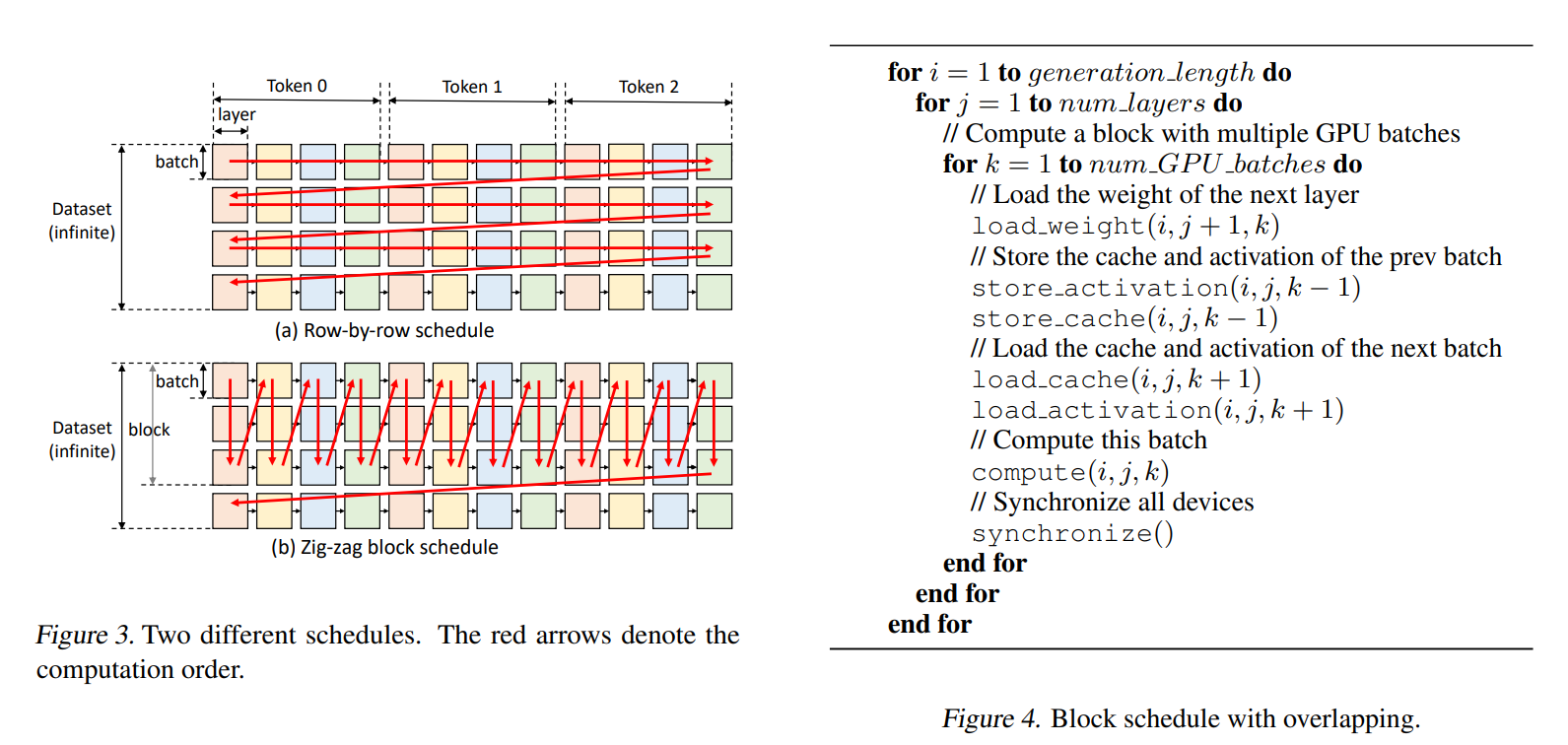
High-throughput Generative Inference of Large Language Models with a Single GPU
MLsys LLM Motivated by the emerging demand for latency-insensitive tasks with batched processing, this paper initiates the study of high-throughput LLM inference using limited resources, such as a single commodity GPU. We present FlexGen, a high-throughput generation engine for running LLMs with limited GPU memory.
https://github.com/FMInference/FlexGen https://www.connectedpapers.com/main/524ebb3283947d152aef3f54f7a7430796745106/High%20throughput-Generative-Inference-of-Large-Language-Models-with-a-Single-GPU/graph
Abstract
FlexGen can be flexibly configured under various hardware resource constraints by aggregating memory and computation from the GPU, CPU, and disk. Through a linear programming optimizer, it searches for efficient patterns to store and access tensors. FlexGen further compresses these weights and the attention cache to 4 bits with negligible accuracy loss. These techniques enable FlexGen to have a larger space of batch size choices and thus significantly increase maximum throughput.
| System | OPT-6.7B | OPT-30B | OPT-175B |
|---|---|---|---|
| Hugging Face Accelerate | 25.12 (2 on GPU) | 0.62 (8 on CPU) | 0.01 (2 on disk) |
| DeepSpeed ZeRO-Inference | 9.28 (16 on CPU) | 0.60 (4 on CPU) | 0.01 (1 on disk) |
| Petals | 8.25 (2 on GPU) | 2.84 (2 on GPU) | 0.08 (2 on GPU) |
| FlexGen | 25.26 (2 on GPU) | 7.32 (144 on CPU) | 0.69 (256 on disk) |
| FlexGen with Compression | 29.12 (72 on GPU) | 8.38 (512 on CPU) | 1.12 (144 on CPU) |
Intro
- Introduced a throughtput-oriented generative inference.
- Methods:
- Model compression
- collaborative inference
- offloading
- Flexgen:
- run 175B on single GPU
- Challenge
- efficient offloading strategies: weights, activation, KV cache
- efficient compression strategies
- Contribution
- linear programming-based search algorithm to optimize the throughput within the search space which contains possible offloading strategies
- compress both the weights and KV cache for LLMs like OPT-175B to 4 bits without retraining or calibration
- Performance
- FlexGen: same latency = 5000s -> #40× higher DeepSpeed Zero-Inference
- higher latency = 12000s, FlexGen achieves #69× higher maximum throughput compared to baselines - allowing 4-bit compression, FlexGen can reach 100× higher maximum throughput with latency = 4000s
- FlexGen: same latency = 5000s -> #40× higher DeepSpeed Zero-Inference
#

Evaluation
https://zhuanlan.zhihu.com/p/615021309
Flexgen系统传播效果好主要是取了一个新颖的视角,还是单/多GPU跑LLM模型,放大了throughout需求,提出一个极端的CPU offload系统,实验中提到,With a higher latency of 12000 s(3.3个小时),batchsize 256,, 69×higherthroughput than DeepSpeed Zero-Inference(b=1),推理延迟已经拉长到3.3个小时了(这也限制它的使用场景,仅适合离线批量计算场景),从并行设计上没有什么特别突出地方,但是敢想(延迟压到3.3个小时)、敢换角度思考(利用高throughout、高延迟特性挖掘跨样本的并行)以及对细节的持续思考(比如进一步量化压缩改进CPU-GPU访存带宽、设计自动方法寻找最优的优化参数)来改进系统。
Offloading Strategy
作者基于一些假设前提,设定了一个形式话抽象,简单的说,就是作者基于zig-zag的并行策略,该策略高优先通过流水等延迟隐藏方法不断向GPU输送batch样本,且GPU端仅仅进行一个Transformer layer的计算,一旦计算完成就对KVcache、激活、weight权重参数进行checkpoint,也是流水化overlapping的将数据转移到CPU DRAM和磁盘;当batch纬度并行达到一定的阶段后,再进入下一个layer的计算,且也是高优先batch纬度并行,同样利用overlapping技术隐藏CPU Dram和磁盘的访存延迟;依次进入下一个layer;直到所有layer完成。到这里肯可能prompt计算完了,然后Generating的token同样按照这样的并行技巧,优先batch并行,然后进行layer并行。
Cost model
基于上面的并行思路,假定我们实现了一个“磁盘-CPU-GPU”的pipeline流水并行系统,来overlapping整个链路中的“计算、数据读、数据写”的延迟,这个完美的系统,但是,多少数据放到磁盘上,多少数据放到cpu端,多少数据放到GPU端,都会影响整体pipeline的效率,故作者给出了一个计算disk磁盘到cpu端拖取数据的耗时的量化结论:  4h1^2是attention的参数大小,2h1h2是2个h1h2 FFN矩阵参数大小,分别乘以2字节(fp16);activation对一个tokens只有一个hidden大小,就是2blsh1(所以从这里可以看出其实没有估算prompt这块的计算,可能耗时占比不大所以忽略吧);KV cache主要2个字节、KV共2个缓存项、seq平均长度、隐藏大小、批大小。加起来就是下面的公式:
4h1^2是attention的参数大小,2h1h2是2个h1h2 FFN矩阵参数大小,分别乘以2字节(fp16);activation对一个tokens只有一个hidden大小,就是2blsh1(所以从这里可以看出其实没有估算prompt这块的计算,可能耗时占比不大所以忽略吧);KV cache主要2个字节、KV共2个缓存项、seq平均长度、隐藏大小、批大小。加起来就是下面的公式:
${dtoc^g}=\frac{1}{\text{disk_to_cpu_bandwidth}} \left(\left(8 h_1^2+4 h_1 \cdot h_2\right) \cdot w d + \\ 4 \cdot b l s \cdot\left(s+\frac{n}{2}\right) \cdot h_1 \cdot c d+2 \cdot b l s \cdot h_1 \cdot h d\right)$
pipeline每个环节都用类似的评估方法形式化除量化公式,然后基于这个量化公式,进行线性规划的优化,寻找一些性能更佳的参数。做理论研究,似乎还可以基于实际情况(不用上面的理论建模),用类似强化学习方法,探索更优的系统参数。因为上面形式化方法偏理想,因为对于一个pipeline,当某一个计算单元需要相关参数的时候,参数在磁盘、cpu和dram上实际占比是不确定的,尤其再考虑不用简化的并行模型(比如,batch数据并行和layer并行是混合的场景,系统模型更加复杂,无法构建这样的形式化模型,也较难收集稳定的性能数据)。
Others
GPU上同时“几个batch以及几个Layers”混跑。GPU上默认先尽最大可能进行batch内/间的数据并行,文章说为了简化工程实现(论文附录分析了还有更优的设计,分析思路有兴趣读者可以继续深入),直到batch计算产生的激活和KVcache把下游memory hierarchy存储空间,比如DRAM,打满(批注: 理论上也可以不用极端的打满,到一个上界应该就不影响系统最终吞吐就可以了,这个上界跟batch size、DRAM访存带宽、GPU计算密度、GPU存储空间有一定的关系,对于特定的GPU和服务器架构,理论上可以实验获取这个超参)  所以,基于上面的假设简化,flexgen的并行重点参照ZiG-zag设计,用通俗话说,极端的用batch填满GPU计算密度,达到一定阶段(就是前面讲的阈值,文章里讲更极端,就是等DRAM或者CPU这些内存被填满)后,再进行下一个layer的计算调度(因为可以不考虑latency,所以这种极端设计也是合理的),参看右侧的伪代码,工程上上面一些步骤要异步实现,将weight、activate、KV cache的存储和更新隐藏(overlapping)到GPU的计算里去(原文: the weight load of the next layer, cache/activation load of the next batch, cache/activation store of the previous batch and the computation of the current batch.)
所以,基于上面的假设简化,flexgen的并行重点参照ZiG-zag设计,用通俗话说,极端的用batch填满GPU计算密度,达到一定阶段(就是前面讲的阈值,文章里讲更极端,就是等DRAM或者CPU这些内存被填满)后,再进行下一个layer的计算调度(因为可以不考虑latency,所以这种极端设计也是合理的),参看右侧的伪代码,工程上上面一些步骤要异步实现,将weight、activate、KV cache的存储和更新隐藏(overlapping)到GPU的计算里去(原文: the weight load of the next layer, cache/activation load of the next batch, cache/activation store of the previous batch and the computation of the current batch.)